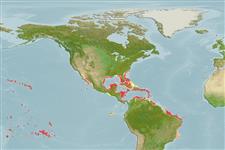Gastropoda |
Not assigned |
Epitoniidae
Environment: milieu / climate zone / djupintervall / distribution range
Ekologi
Revassocierade; djupintervall 0 - 60 m (Ref. 83934). Tropical; 34°N - 20°S, 90°E - 15°E (Ref. 83435)
Western Atlantic and Eastern Pacific.
Length at first maturity / Size / Weight / Age
Könsmognad: Lm ? range ? - ? cm Max length : 3.4 cm DL hane/ej könsbestämd; (Ref. 83435)
This species is found offshore, sub- and intertidal, in coral reefs, reef lagoons, and cienaga facies, particularly on coral, rock and sandy habitats (Ref. 83934). Also on seagrass (Ref. 109264).
Life cycle and mating behavior
Könsmognad | Reproduktion | Lek | Eggs | Fecundity | Larvae
Members of the order Neotaenioglossa are mostly gonochoric and broadcast spawners. Life cycle: Embryos develop into planktonic trocophore larvae and later into juvenile veligers before becoming fully grown adults.
Miloslavich, P., J.M. Díaz, E. Klein, J.J. Alvarado, C. Díaz, J. Gobin, E. Escobar-Briones, Motta, J.J. Cruz, E. Weil, J. Cortés, A.C. Bastidas, R. Roberston, F. Zapata, A. Martín, J. Castillo, A. Kazandjian and M. Ortiz 2010 Marine biodiversity in the Caribbean: regional estimates and distribution patterns. PLoS ONE 5(8):e11916. (Ref. 86671)
IUCN Red List Status
(Ref. 130435: Version 2025-1)
CITES status (Ref. 108899)
Not Evaluated
Not Evaluated
Threat to humans
Human uses
| FishSource |
Verktyg
Ytterligare information
Trophic EcologyFood items (preys)
Födosammansättning
Födointag
Predatorer
Population dynamicsTillväxt
Max. ages / sizes
Length-weight rel.
Length-length rel.
Length-frequencies
Mass conversion
Abundans
PhysiologySyreförbrukning
Human RelatedStamps, coins, misc.
Internet-källor
Estimates based on models
Preferred temperature
(Ref.
115969): 24.5 - 28, mean 27 (based on 264 cells).
Fishing Vulnerability
Low vulnerability (10 of 100).
Price category
Unknown.
